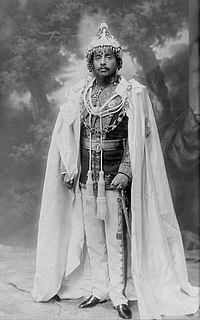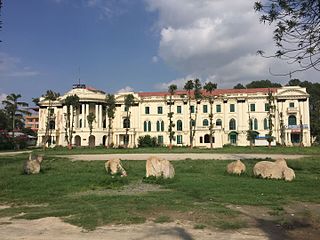
Gorkha Kingdom was a kingdom in the confederation of 24 states known as Chaubisi rajya, on the Indian subcontinent, present-day western Nepal. The Kingdom of Gorkha extended from the Marshyangdi River in the west to the Trishuli River in the east, which separated it from the kingdoms of Lamjung and Nepal respectively. The Gorkha Kingdom was established by Prince Dravya Shah, second son of King Yasho Brahma Shah of Lamjung Kingdom, in 1559 CE replacing the Khadka chiefs.

Field-Marshal Shree Shree Shree Maharaja Sir Mohan Shumsher Jung Bahadur Rana, GCB, GCIE, GBE was the prime minister and foreign minister of Nepal from 30 April 1948 until 12 November 1951.

Rana dynasty is a Chhetri dynasty that ruled the Kingdom of Nepal from 1846 until 1951, reducing the Shah monarch to a figurehead and making Prime Minister and other government positions held by the Ranas hereditary. They claimed Kshatriya status themselves. Rana dynasty is historically known for the iron-fisted rule. This changed after the Revolution of 1951 with the promulgation of a new constitution, when power shifted back to the monarchy of King Tribhuvan.

The Rastrapati Bhawan is the official residence of the President of Nepal, located in Kathmandu, Nepal. It hosts the Office of The President of Nepal. The main palace building was and still is known as Sital Niwas. It was built by Rana Prime Minister Chandra Shumsher JBR in 1923.

Field Marshal Sir Kaiser Shumsher Jang Bahadur Rana, GBE was a field marshal in the Royal Nepalese Army. He was the third son of Maharaja Sir Chandra Shamsher Jang Bahadur Rana, GCB, GCSI, GCMG, GCVO the fifth Prime Minister of Nepal of the Rana dynasty and Bada Maharani Chandra Loka Bhaktha Rajya Lakshmi. He was the younger brother of Shree Tin Maharaja Sir Mohan Shamsher Jang Bahadur Rana and Sir Baber Shamsher Jang Bahadur Rana.

Commanding General Shree Shree Shree Maharaja Sir Bir Shumsher Jung Bahadur Rana was the 11th Prime Minister of Nepal. He is remembered as a statesman who made important reforms and infrastructure improvements. Bir Shamsher Jung Bahadur Rana was known as Kailay in his childhood; this name was given by Jung Bahadur. His mother was daughter of Pahalman Singh Basnyat and sister of lalitman Singh Basnyat .His mother died as soon as he was born and he was taken care of by Putali Maharani, wife of Jung Bahadur. He spent his childhood at Thapathali Durbar.

Field-Marshal Maharaja Sri Teen Chandra Shumsher Junga Bahadur Rana was the Prime Minister of Nepal from the Rana dynasty. He served in this capacity from 27 June 1901 to his death in 1929, after he successfully deposed his liberal and reformist brother Dev Shamsher. Although generally perceived as despotic and conservative, he is credited with several reforms including the abolition of slavery and the Nepal-Britain Treaty of 1923, which recognized Nepal as an independent nation and an ally of Britain.

Following the German invasion of Poland, the Kingdom of Nepal declared war on Germany on September 4, 1939. Once Japan entered the conflict, sixteen battalions of the Royal Nepalese Army fought on the Burmese front. In addition to military support, Nepal contributed guns, equipment as well as hundreds of thousands of pounds of tea, sugar and raw materials such as timber to the Allied war effort.

Sri Maharaja, Dev Shamsher Jung Bahadur Rana was the Prime Minister of Nepal for 114 days in 1901. He was also the King of Lamjung and Kaski.
Rana in Arabic ; the name means "glittering object", "noticeable", stemming from the word yarnū, meaning "to gaze at longingly". It is a given name for females in Arabic-speaking countries.

The bilateral relations between India and Taiwan have improved since the 1990s, despite both nations not maintaining official diplomatic relations. India recognises only the People's Republic of China and not the Republic of China's claims of being the legitimate government of Mainland China, Hong Kong, and Macau - a conflict that emerged after the Chinese Civil War (1945–49). However, India's economic and commercial links as well as people-to-people contacts with Taiwan have expanded in recent years.
The Third Nepal-Tibet War was fought from 1855 to 1856 in Tibet between the forces of the Tibetan government Tamang/Moormis, then under administrative rule of the Qing dynasty) and the invading Nepalese army, resulting in huge loss of money and manpower for Tibet and Nepal. In 1856 the war ended with the Treaty of Thapathali.
The Nepal–Britain Treaty was first discussed in 1921 and the final treaty was signed on 21 December 1923 in Singha Durbar. The treaty was the first formal acknowledgement by the British that Nepal, as an independent nation, had the right to conduct its foreign policy in any way it seems fit and is considered to be “a great achievement of 25 years of Chandra Shumsher’s diplomacy.” The treaty was recorded in 1925 in the League of Nations.

The banishment of Buddhist monks from Nepal was part of a campaign by the Rana government to suppress the resurgence of Theravada Buddhism in Nepal in the early the 20th century. There were two deportations of monks from Kathmandu, in 1926 and 1944.

Bag Durbar, is a palace built and resided by Thapa regime in Kathmandu, the capital of Nepal. The palace complex, located west of the Dharahara and Tundikhel, incorporates an impressive and vast array of courtyards, gardens and buildings. Initially the palace was owned by Amar Singh Thapa (Sardar) of Thapa regime and his descendant but later was occupied by Royals of Shah dynasty, and later by government of Nepal.

Sita Bhawan is a Rana palace in Kathmandu, the capital of Nepal. The palace complex, located East of the Narayanhity Palace, was incorporated in an impressive and vast array of courtyards, gardens and buildings. Sita Bhawan was built by Bhim Shamsher Jang Bahadur Rana in 1929 for his wife Her Highness Sri Teen Sita Bada Maharani Deela Kumari Devi.

Harihar Bhawan is a Rana palace in Patan, Nepal the capital of the Nepal. The palace complex, located west of the Sri Durbar, was incorporated in an impressive and vast array of courtyards, gardens and buildings.

Shree Durbar is a Rana palace in Kathmandu, Patan, Nepal the capital of Nepal. The palace complex, located east of the Lazimpat Durbar next to Patan Dhoka, was incorporated in an impressive and vast array of courtyards, gardens and buildings. Sri Durbar was built by Chandra Shumsher JBR in 1927.

Dhir Shamsher Kunwar after 1848 known as Dhir Shamsher Kunwar Ranaji or Dhir Shamsher Jang Kunwar Ranaji or shortly Dhir Shamsher Rana posthumously known as Dhir Shamsher Jang Bahadur Rana was a Nepalese politician, army general and minister of state. He served as the Commander-In-Chief of the Nepalese Army from 1879 to 1884 A.D. He was born in Kunwar family as the youngest son of Kaji Bal Narsingh Kunwar and Ganesh Kumari Thapa, daughter of Kaji Nain Singh Thapa of Thapa dynasty. Dhir Shamsher was the youngest brother of Jang Bahadur Kunwar Ranaji, who rose to premiership of Nepal after the murders of influential persons - Mathabarsingh Thapa and Gagan Singh Bhandari and the incidence of Kot Massacre. Dhir was personally involved in the massacre protecting his nearly slaughtered brother Krishna Bahadur Kunwar Rana. Dhir became military Colonel after the incident. He was in the entourage of Jung Bahadur's visit of Europe in the early 1850s.

Jagat Jang Kunwar Rana, popularly known as Jagat Jang Rana was a Nepalese politician, military officer and courtier in the Kingdom of Nepal. He was the eldest son of the founder of Rana dynasty, Jung Bahadur Kunwar Rana. He claimed the Premiership of Kingdom of Nepal and the throne of Maharaja of Lamjung and Kaski against the traditional agnatic succession of the Rana dynasty. Driven by this motive, he attempted a coup against his uncles; Maharaja Prime Minister Ranodip Singh Kunwar and Commander-In-Chief Dhir Shamsher Kunwar Rana in the winter of 1881-1882. He was immediately thrown out of the roles of succession among Ranas. Later, he was pardoned and was impeased by Ranodip Singh as his successor after the death of Dhir Shamsher, which caused envy among his Shamsher cousins and ultimately led to his death in the 1885 Shamsher coup.

















